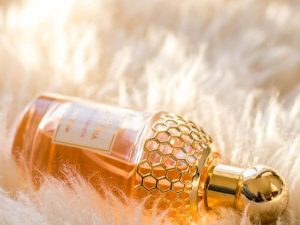Whether to contemplate your next acquisition or to become more expert on the subject, we tell you how perfumes are made, the types that exist, and more!
The best weapon of expression and, without a doubt, an entire olfactory work of art, that is what perfumes are ! Because beyond a mere mixture of fragrances, they have their own voice and personality, which are noted through the powerful set of chords that make them up, as if it were a DNA.
From its composition to the process they follow to come to life and, of course, the intention under which they were created, these are just some of the secrets that tell the story of a fragrance, which we review today in great detail, to help you choose your next perfume like an expert.
Contents
What are perfumes?
Perfumes are the result of a composition of natural and/or synthetic essences that, when combined, result in a unique and distinctive patented aroma for each brand. It is precisely these concentrated aromatic substances that make up each formula, which are known as fragrances . These, unlike perfumes , are usually sold in specialized or naturist houses, since they are the raw materials to create commercial formulas.
This is how, depending on the series of fragrances used, perfumes can be classified according to their structure as monolithic, which are created with one or very few essences; or, by multiple phases, dividing hierarchically as an olfactory pyramid.
What are they made of?
Regardless of the brand and the manufacturing process of each one, the way perfumes are made is based on a compilation of multiple natural or synthetic fragrances, solvent and fixative. A mixture that, although it sounds simple, brings together at least 20 components, which, depending on their concentration, give the formula a different name, helping its classification.
Classification of perfumes
Beyond the number of essences that intermingle, the classification of the most popular perfumes is based on their composition, taking into account characteristics such as their density, intensity and duration. That is why we can find aromatic formulas of different types that adapt to each need! Here are the variants that exist:
Fragrance
It is the most intense wearable version of a fragrance whose concentration of ingredients reaches 20% to 30%. Thanks to its density, it can last on the skin between 12 and 24 hours, being perfect for those who love to keep an aroma intact throughout the day and without the need to reapply it.
What are olfactory notes?
Olfactory notes are the series of natural or synthetic essences that, when mixed in a harmonious and well-ordered way, make up the iconic aroma of a perfume . In fact, such is their importance within each formula, that it could be said that they are the ones that make up the soul of it, making it memorable and distinctive.

Types of olfactory notes
In order to make the classification of perfumes much easier and, above all, to facilitate the proper choice of those who carry them, the notes are divided into 7 olfactory families:
floral
Traditional and cheerful, such are the floral notes that, being one of the oldest notes, are also one of the most popular. These can be made up of a single flower (soliflore) or different varieties of them (bouquet), just as they can be enriched with accessory notes, dividing into varieties such as green, aquatic floral notes and more.
citrus
Also known as hesperidia, citrus notes are distinguished by their soft and fresh aroma, coming from the dried peels of fruits such as lemon, orange, tangerine or bergamot, among others.
Cyprus
Sophistication and elegance are two of the qualities that distinguish the notes of the chypre family. These are distinguished by being light and very fresh fragrances but with a contrasting and deep base, with an earthy or leather-like essence.
woody
As its name indicates, woody notes encompass all those woody fragrances such as moss, pine, cedar, ferns, sandalwood, patchouli and more. While they tend to be very similar to fougère notes, they are much more robust and warm.
Fougere
Alluding to its name in French which means fern, these notes refer to the woody green and somewhat woody fragrances that tend to be used usually within masculine perfumes .
Orientals
With great fixation and voluptuousness, the oriental notes, also called ambaradas, are distinguished by being warm notes with a subtle sweet touch. These tend to be intense and very noticeable perfumes that intermingle woods, spices, flowers and musks with a sensual soul. That’s why they are the favorites of winter!
gourmand
As if it were a dessert, the gourmand family classifies sweet notes with spicy nuances that, due to its rare mix of almost edible fragrances, is completely innovative. And it is that although these mixtures usually contain certain touches of vanilla or robust flowers, they also tend to be somewhat more artificial as they allude to aromas that are rarely found in nature.
What is an olfactory pyramid?
As you may have noticed on more than one occasion, perfumes are versatile formulas whose aroma evolves while you wear it, taking on a different personality as the hours go by. This is achieved thanks to the olfactory pyramid under which they are constituted, which hierarchizes the multiple notes from different aromatic families that make it up, dividing them into:
output notes
Also called head notes, they refer to the predominant aroma that is perceived as soon as the perfume is applied, leaving a first impression by opening the sense of smell.
heart notes
This is the soul of the perfume, as they are the notes that define its essence as they remain impregnated on the skin for up to 6 hours, even when the top notes have already disappeared.
background notes
These are the base notes that provide depth and intensity to the fragrance, which are present up to two hours after being impregnated on the skin.
How to choose your ideal perfume?
Beyond a simple taste, you can choose a perfume according to your mood, your memories, your skin type and even according to the season in which you find yourself. We explain how it works with each one:
Choice of perfumes by mood : there are aromas that are related to different emotions. Citrus fruits are associated with energy and good humor, oriental ones with warmth and mystery, floral ones with calm and freshness, etc. Depending on the mood you have or are looking for, it is how you can choose it.
Choice of perfumes by memories : did you know that a perfume can transport you to the best moment of your life? That’s right and it’s due to olfactory memory. It is a process that unites brain activity and smell, that is, when perceiving an aroma, the brain captures it, feels it and associates it with a memory and its emotions. If there is a fragrance that always takes you back to a special event, it happens because of this phenomenon and you can choose it when you need a boost of joy or nostalgia.
Choosing perfumes by skin type: Skin type is also an important factor when selecting a fragrance. For oily skin, citrus, fruity and floral aromas are suggested, as their characteristics intensify the scent. For dry skin, woody, oriental, robust floral or sweet scents are more recommended.
Choice of perfumes by season : as you know, floral, citrus and fruity perfumes predominate in spring, herbal and aquatic in summer, woody and sweet in autumn, and spicy and musky in winter. Remember that here we only give you a guide, but you make the final decision to choose the perfume that best suits you!
Perfumes according to the season of the year
If you will let yourself be guided by the climate and environment according to the month in which you find yourself for your next purchase of perfumes , we leave you with some suggestions that should not be missing from your dressing table.









